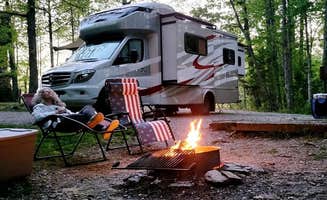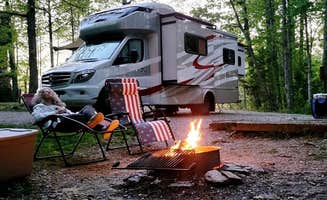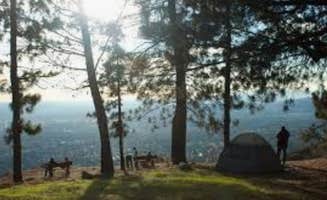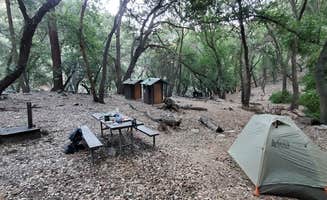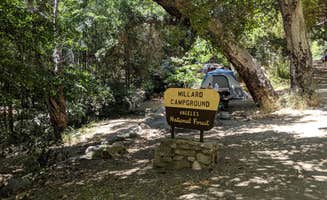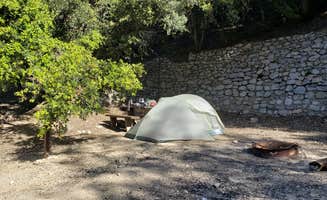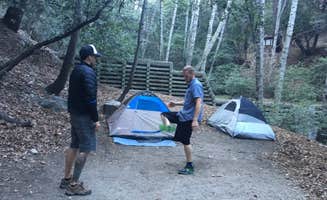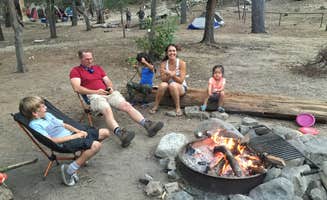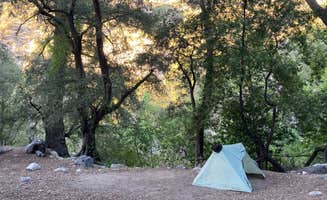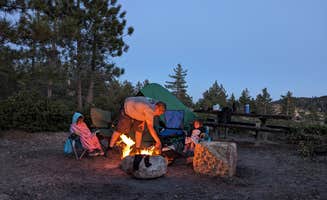Camping in the San Gabriel Mountains spans elevations from 2,000 to 8,000 feet, creating distinct temperature zones where higher camps can be 15-20 degrees cooler than lower elevations. Trail camps without vehicle access form a network along major hiking corridors, with several connected to the 2,650-mile Pacific Crest Trail. Fire restrictions vary seasonally based on conditions rather than fixed dates.
What to do
Waterfall hikes: Take a 30-minute hike upstream from Millard Trail Campground to reach a scenic waterfall. "Bikepacked in for a quick overnighter. Nice campground, active stream in the middle of summer. Waterfall 30 minutes hike upstream," notes Jeff B.
Mountain biking: Bring dirt bikes to explore designated trails near Crystal Lake Recreation Area. "Bring your dirt bike and hit some of the trails, it's a definite must!" recommends Salem L. The recreation area offers various trail difficulty levels across its extensive grounds.
Night sky viewing: Several elevated campsites provide exceptional stargazing opportunities after dark. "This is a special place and a bit of an uphill hike, very rustic and incredible views at night looking over Los Angeles about 25 miles away," shares a visitor about Mount Lowe.
Wildlife watching: Early mornings offer the best animal sighting opportunities. "Animals seen: Black bear, deer (wandered through our site), red foxes, Stellar's Jays, woodpeckers, other birds," reports Forest G. from Crystal Lake.
What campers like
Creek access: Many trail camps feature running water during spring and early summer. At Hoegees Trail Camp, "There is a creek that runs through. It's beautiful and feels completely isolated," reports Morgan F. Stream water requires filtration or treatment before drinking.
Uncrowded weekday camping: Mid-week visits offer significantly more solitude at most sites. "I went during the week and was the only one camping. This place is heavily used for day camping and hiking," explains a camper at Millard Trail.
Wood-burning cooking options: Several backcountry sites maintain cooking infrastructure. At Hoegees, each site features "table, fire ring and wood-burning stove," according to David F. These facilities remain subject to seasonal fire restrictions.
Proximity to urban areas: Despite wilderness feel, most camps remain relatively accessible. "This is a hike in only campground that is secluded and a little spare. It has no running water but it does have facilities and tables (first come, first serve)," explains Tom P. about Mount Lowe Trail Campground.
What you should know
Water availability: Potable water access varies by location and season. At Chilao Campground, "We were told that the water pumps were off but actually managed to camp right next to the one that was working," reports Amairani P. Always confirm current water status before arrival.
Parking limitations: Many trail camps require secured overnight parking. "WARNING: Make sure to leave your car doors unlocked, and nothing of value inside. You'd rather have someone root through your car and walk away empty handed than have a window broken and items stolen," advises Mathew H. about Millard Trail Camp.
Bear activity: Food storage requirements exist at multiple sites. "It's important to keep all of your food and anything with any kind of smell in the bear boxes," warns a camper at Crystal Lake. Always follow posted wildlife guidelines.
Seasonal closures: Higher elevation sites close during winter months. Chilao Campground operates "April to November" according to official listings, with seasonal variations possible based on weather conditions.
Tips for camping with families
Short hike options: Consider camps with minimal approach distances for younger children. Valley Forge Trail Camp offers "an easy 3.5 mile hike in, but a tough hike out of the canyon," according to Kelly B. Plan accordingly for return journeys which often involve elevation gain.
Safety precautions: Prepare children for wildlife encounters before arrival. "I saw two to three cabins along the outskirts of the campground that I assume were for rentals," notes a visitor to Millard, providing alternative accommodations for families not ready for tent camping.
Stream exploration: Creek-adjacent sites provide natural play areas. "In April the creek was full, with several creek crossings on the hike and crisp, fresh water along the campsite that contribute to a beautifully green oasis of a meadow," reports Kelly B. about Valley Forge Trail Camp.
Weather considerations: Mountain weather can change rapidly, particularly at higher elevations. "Even though the daily high was 79 degrees, the low at night was 56, and it was still only 61 degrees by 7 am," notes a camper at Chilao.
Tips from RVers
RV size limitations: Most developed campgrounds accommodate smaller RVs only. At Bonelli Bluffs, "Every site has full hookups and sewer," reports Michael S., making it one of the few San Gabriel Valley options with comprehensive RV facilities.
Reservation recommendations: RV-friendly sites fill quickly during peak seasons. "A little pricey but very nice facility. All hookups 30/50 amp. Cable TV. There's a pool. Some spaces monumentally better than others," notes Dennis B. about Bonelli Bluffs.
Leveling challenges: Mountain campgrounds often feature uneven terrain. "Awesome for RVs but maybe not the best for tent camping," explains Sara H. about Bonelli Bluffs, noting that "they do have the tent camping on the steep incline."
Dump station access: Plan waste management accordingly as facilities vary. Several campers note that Crystal Lake Recreation Area provides sanitary dump facilities, while most trail camps have no such services.


